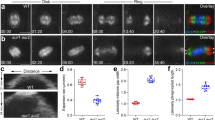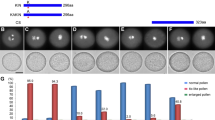Abstract
Aurora kinases are involved in various mitotic events, including chromosome segregation and bipolar mitotic spindle assembly. In animals, Aurora A is activated and protected by microtubule-associated protein TPX2. Such role in plants is not known. Here, we have assessed the ability of TPX2 of Arabidopsis to regulate Aurora family members in vitro. AtTPX2 acts as substrate as well as activator of AtAurora1, but not AtAurora3. Truncated version of AtTPX2 lacking the Aurora binding domain is unable to activate the kinases; however, it is still phosphorylated. AtTPX2-induced activation of AtAurora1 results in a dramatically increased phosphorylation level of downstream targets, particularly histone H3. The differences in the activation mechanism of AtAurora1 and 3 point to a specific regulation of both kinases, which may play an important role in cell cycle regulation and signaling cascade transduction in plants.




Similar content being viewed by others
References
Altschul SF, Gish W, Miller W, Myers EW, Lipman DJ (1990) Basic local alignment search tool. J Mol Biol 215:403–410
Bayliss R, Sardon T, Vernos I, Conti E (2003) Structural basis of Aurora-A activation by TPX2 at the mitotic spindle. Mol Cell 12:851–862
Bibby RA, Tang C, Faisal A, Drosopoulos K, Lubbe S, Houlston R, Bayliss R, Linardopoulos S (2009) A cancer-associated Aurora A mutant is mislocalized and misregulated due to loss of interaction with TPX2. J Biol Chem 284:33177–33184
Binarová P, Cenklová V, Procházková J, Doskočilová A, Volc J, Vrlík M, Bögre L (2006) Gamma-tubulin is essential for acentrosomal microtubule nucleation and coordination of late mitotic events in Arabidopsis. Plant Cell 18:1199–1212
Demidov D, Van Damme D, Geelen D, Blattner FR, Houben A (2005) Identification and dynamics of two classes of aurora-like kinases in Arabidopsis and other plants. Plant Cell 17:836–848
Demidov D, Hesse S, Tewes A, Rutten T, Fuchs J, Ashtiyani RK, Lein S, Fischer A, Reuter G, Houben A (2009) Aurora1 phosphorylation activity on histone H3 and its cross-talk with other post-translational histone modifications in Arabidopsis. Plant J 59:221–230
Evrard JL, Pieichot L, Vos JW, Vernos I, Schmit AC (2009) Plant TPX2 and related proteins. Plant Signal Behav 4:69–72
Eyers PA, Erikson E, Chen LG, Maller JL (2003) A novel mechanism for activation of the protein kinase Aurora A. Curr Biol 13:691–697
Gruss OJ, Vernos I (2004) The mechanism of spindle assembly: functions of Ran and its target TPX2. J Cell Biol 166:949–955
Iyer J, Tsai MY (2012) A novel role for TPX2 as a scaffold and co-activator protein of the chromosomal passenger complex. Cell Signal 2012(24):1677–1689
Karsenti E, Vernos I (2001) The mitotic spindle: a self-made machine. Science 294:543–547
Katayama H, Sasai K, Kloc M, Brinkley BR, Sen S (2008) Aurora kinase-A regulates kinetochore/chromatin associated mikrotubule assembly in human cells. Cell Cycle 7:2691–2704
Kawabe A, Matsunaga S, Nakagawa K, Kurihara D, Yoneda A, Hasezawa S, Uchiyama S, Fukui K (2005) Characterization of plant Aurora kinases during mitosis. Plant Mol Biol 58:1–13
Kufer TA, Silljé HH, Körner R, Gruss OJ, Meraldi P, Nigg EA (2002) Human TPX2 is required for targeting Aurora-A kinase to the spindle. J Cell Biol 158:617–623
Kurihara D, Matsunaga S, Kawabe A, Fujimoto S, Noda M, Uchiyama S, Fukui K (2006) Aurora kinase is required for chromosome segregation in tobacco BY-2 cells. Plant J 48:572–580
Kurihara D, Sachihiro M, Uchiyama S, Fukui K (2008) Live cell imaging reveals plant aurora kinase has dual roles during mitosis. Plant Cell Physiol 49:1256–1261
Marumoto T, Zhang D, Saya H (2005) Aurora A — a guardian of poles. Nat Rev Cancer 5:42–50
Murata T, Sonobe S, Baskin TI, Hyodo S, Hasezawa S, Nagata T, Horio T, Hasebe M (2005) Microtubule-dependent microtubule nucleation based on recruitment of gamma-tubulin in higher plants. Nat Cell Biol 7:961–968
Neumayer G, Helfricht A, Shim SY, Le HT, Lundin C, Belzil C, Chansard M, Yu Y, Lees-Miller SP, Gruss OJ, can Attikum H, Helleday T, Nguyen MD (2012) Targeting protein for xenopus kinesin-like protein 2 (TPX2) regulates gamma histone 2AX (gamma-H2AX) levels upon ionizing radiation. J Biol Chem 287:42206–42222
Notredame C, Higgins DG, Heringa J (2000) T-Coffee: a novel method for fast and accurate multiple sequence alignment. J Mol Biol 302:205–217
Petrovská B, Cenklová V, Pochylová Ž, Kourová H, Doskočilová A, Plíhal O, Binarová L, Binarová P (2012) Plant Aurora kinases play a role in maintenance of primary meristems and control of endoreduplication. New Phytol 193:590–604
Petrovská B, Jeřábková H, Chamrád I, Vrána J, Lenobel R, Uřinovská J, Šebela M, Doležel J (2014) Proteomic analyses of barley cell nuclei purified by flow sorting. Cytogenet. Genome Res 143:78–86
Petrovská B, Jeřábková H, Kohoutová L, Cenklová V, Pochylová Ž, Gelová Z, Kočárová G, Váchová L, Kurejová M, Tomaštíková E, Binarová P (2013) Overexpressed TPX2 causes ectopic formation of microtubular arrays in the nuclei of acentrosomal plant cells. J Exp Bot 64:4575–4587
Stewart S, Fang G (2005) Anaphase promoting complex/cyclosome controls the stability of TPX2 during mitotic exit. Mol Cell Biol 25:10516–10527
Tsai MY, Zheng Y (2005) Aurora A kinase-coated beads function as microtubule-organizing centers and enhance RanGTP-induced spindle assembly. Curr Biol 15:2156–2163
Van Damme D, De Rybel B, Gudesblat G, Demidov D, Grunewald W, De Smet I, Houben A, Beeckman T, Russinova E (2011) Arabidopsis alpha Aurora kinases function in formative cell division plane orientation. Plant Cell 23:4013–4024
Vos JW, Pieuchot L, Evrard JL, Janski N, Bergdoll M, De Ronde D, Perez LH, Sardon T, Vernos I, Schmit AC (2008) The plant TPX2 protein regulates prospindle assembly before nuclear envelope breakdown. Plant Cell 20:2783–2797
Walter AO, Seghezzi W, Korver W, Sheung J, Lees E (2000) The mitotic serine/threonine kinase Aurora2/AIK is regulated by phosphorylation and degradation. Oncogene 19:4906–4916
Wittmann T, Wilm M, Karsenti E, Vernos I (2000) TPX2, A novel xenopus MAP involved in spindle pole organization. J Cell Biol 149:1405–1418
Acknowledgments
We thank Oda Weiss for the excellent technical support. This research was supported by grants from the Czech Science Foundation (14-28443S) and the National Program of Sustainability I (LO1204); Internal Grant Agency of Palacky University, Olomouc (IGA_PrF_2014001, PrF-2013-003) and Interdoc (OPVK-CZ.1.07/2.4.00/17.0008) for ET and HJ. DD and AH are supported by the DFG (SFB 648). Grant from the Czech Science Foundation P501-12-2333 for PB. We thank Dr. H. P. Mock for helpful discussion about protein purification.
Author information
Authors and Affiliations
Corresponding authors
Additional information
Eva Tomaštíková and Dmitri Demidov contributed equally to this work.
Electronic supplementary material
Below is the link to the electronic supplementary material.
Figure S1
Analyses of putative TPX2-interaction motif in AtAurora1 plant homologues. Multiple sequence alignment revealed high level of similarity in the TPX2 interaction motif between AtAurora1 and its plant homologues. Black arrows indicate the conserved amino acids. Blue arrows indicate the amino acids involved in interaction with TPX2 which are not conserved. (PDF 15183 kb)
Figure S2
Analyses of putative TPX2-interaction motif in AtAurora3 plant homologues. Multiple sequence alignment revealed high level of similarity in the TPX2 interaction motif between AtAurora3 and its plant homologues. Black arrows indicate the conserved amino acids. Blue arrows indicate the amino acids involved in interaction with TPX2 which are not conserved. Red frame indicated differences between AtAurora 1 and AtAurora3 homologues. (PDF 13295 kb)
Figure S3
Alignment of Arabidopsis and human Aurora kinases. Multiple sequence alignment revealed high level of similarity in the TPX2 interaction motif between Arabidopsis and human Aurora kinase genes. Black arrows indicate conserved amino acids at potential TPX2-interaction region. Blue arrows indicate the amino acids which are not conserved. In the red frame are amino acids different between AtAurora1 and AtAurora3. (PDF 3245 kb)
Figure S4
Analyses of putative AuroraA-binding sites in AtTPX2 plant homologues. Multiple sequence alignment revealed high level of similarity in the AuroraA binding site of AtTPX2 and its plant homologues. Black arrows indicate conserved amino acids for AuroraA binding region, based on analyses of non-plant TPX2 proteins. Green arrows indicate conserved amino acids exclusively in plant TPX2 Aurora1 binding region. (PDF 7743 kb)
Figure S5
Analyses of putative AuroraA-binding sites in Arabidopsis TPX2-related proteins. Multiple sequence alignment revealed absence of AuroraA-interacting region in different splicing variants of TPX2-related proteins. (PDF 3924 kb)
Figure S6
Expression and purification of recombinant proteins. a – SDS-PAGE separation of purified MBP-tagged AtAurora3 (lane 1) and GST-tagged AtAurora1 (lane 2) after Commasie Brilliant Blue (CBB) staining. The positions and respective size of recombinant proteins are indicated. b – SDS-PAGE separation of purified His-tagged AtTPX2ΔN (truncated version of AtTPX2 without Aurora binding domain) and full length AtTPX2 protein. The positions and sizes of recombinant proteins are indicated. Degradation products of AtTPX2 are marked with asterisks. b – SDS-PAGE separation of purified His-tagged At histone H3 after CBB staining. (GIF 59 kb)
Figure S7
In vitro activation of AtAurora1 by AtTPX2 causes increased phosphorylation of downstream targets. a – In vitro phosphorylation of histone H3 is markedly increased after activation of AtAurora1 by AtTPX2. Comparison of AtAurora1 activity without (lane 3) and with (lane 7) addition of AtTPX2 as kinase coactivator. b – In vitro phosphorylation of histone H3 is not increased after AtAurora3 incubation with AtTPX2. (GIF 171 kb)
Rights and permissions
About this article
Cite this article
Tomaštíková, E., Demidov, D., Jeřábková, H. et al. TPX2 Protein of Arabidopsis Activates Aurora Kinase 1, But Not Aurora Kinase 3 In Vitro. Plant Mol Biol Rep 33, 1988–1995 (2015). https://doi.org/10.1007/s11105-015-0890-x
Published:
Issue Date:
DOI: https://doi.org/10.1007/s11105-015-0890-x




